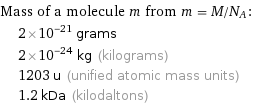Input interpretation
![tris[trinitratocerium(IV)]paraperiodate | molar mass](../image_source/9c334e04da5e15d62924ec9b8379b9b3.png)
tris[trinitratocerium(IV)]paraperiodate | molar mass
Result
![Find the molar mass, M, for tris[trinitratocerium(IV)]paraperiodate: M = sum _iN_im_i Plan: • Write the chemical formula and gather atomic masses from the periodic table. • Determine values for N_i and m_i using these items. • Finally, compute the mass. Write the chemical formula: [Ce(NO_3)_3]_3(H_2IO_6) Use the chemical formula to count the number of atoms, N_i, for each element: | N_i Ce (cerium) | 3 H (hydrogen) | 2 I (iodine) | 1 N (nitrogen) | 9 O (oxygen) | 33 Look up the atomic mass, m_i, in g·mol^(-1) for each element in the periodic table: | N_i | m_i/g·mol^(-1) Ce (cerium) | 3 | 140.116 H (hydrogen) | 2 | 1.008 I (iodine) | 1 | 126.90447 N (nitrogen) | 9 | 14.007 O (oxygen) | 33 | 15.999 Multiply N_i by m_i to compute the mass for each element. Then sum those values to compute the molar mass, M: Answer: | | | N_i | m_i/g·mol^(-1) | mass/g·mol^(-1) Ce (cerium) | 3 | 140.116 | 3 × 140.116 = 420.348 H (hydrogen) | 2 | 1.008 | 2 × 1.008 = 2.016 I (iodine) | 1 | 126.90447 | 1 × 126.90447 = 126.90447 N (nitrogen) | 9 | 14.007 | 9 × 14.007 = 126.063 O (oxygen) | 33 | 15.999 | 33 × 15.999 = 527.967 M = 420.348 g/mol + 2.016 g/mol + 126.90447 g/mol + 126.063 g/mol + 527.967 g/mol = 1203.298 g/mol](../image_source/32f487d74962a0bd12197ca50bbcb59f.png)
Find the molar mass, M, for tris[trinitratocerium(IV)]paraperiodate: M = sum _iN_im_i Plan: • Write the chemical formula and gather atomic masses from the periodic table. • Determine values for N_i and m_i using these items. • Finally, compute the mass. Write the chemical formula: [Ce(NO_3)_3]_3(H_2IO_6) Use the chemical formula to count the number of atoms, N_i, for each element: | N_i Ce (cerium) | 3 H (hydrogen) | 2 I (iodine) | 1 N (nitrogen) | 9 O (oxygen) | 33 Look up the atomic mass, m_i, in g·mol^(-1) for each element in the periodic table: | N_i | m_i/g·mol^(-1) Ce (cerium) | 3 | 140.116 H (hydrogen) | 2 | 1.008 I (iodine) | 1 | 126.90447 N (nitrogen) | 9 | 14.007 O (oxygen) | 33 | 15.999 Multiply N_i by m_i to compute the mass for each element. Then sum those values to compute the molar mass, M: Answer: | | | N_i | m_i/g·mol^(-1) | mass/g·mol^(-1) Ce (cerium) | 3 | 140.116 | 3 × 140.116 = 420.348 H (hydrogen) | 2 | 1.008 | 2 × 1.008 = 2.016 I (iodine) | 1 | 126.90447 | 1 × 126.90447 = 126.90447 N (nitrogen) | 9 | 14.007 | 9 × 14.007 = 126.063 O (oxygen) | 33 | 15.999 | 33 × 15.999 = 527.967 M = 420.348 g/mol + 2.016 g/mol + 126.90447 g/mol + 126.063 g/mol + 527.967 g/mol = 1203.298 g/mol
Unit conversion

1.2033 kg/mol (kilograms per mole)
Comparisons

≈ 1.7 × molar mass of fullerene ( ≈ 721 g/mol )

≈ 6.2 × molar mass of caffeine ( ≈ 194 g/mol )

≈ 21 × molar mass of sodium chloride ( ≈ 58 g/mol )
Corresponding quantities

Mass of a molecule m from m = M/N_A: | 2×10^-21 grams | 2×10^-24 kg (kilograms) | 1203 u (unified atomic mass units) | 1.2 kDa (kilodaltons)

Relative molecular mass M_r from M_r = M_u/M: | 1203